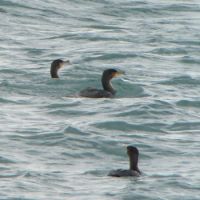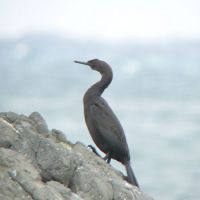It is 50 years this year since the best-selling band in history, The Beatles, released their first single, "Love Me Do." They were set to catapult Britain into the Swinging '60s and launch a global musical phenomenon.
It wasn't so much that many of their singles and LPs sold in vast quantities, but that their music went viral. From cafes and clubs to ships and shops, from Alaska to New Zealand, from Chile to Russia — 50 years on, Beatles music, and countless reinterpretations of it, continues to carry the so-called Liverpool Sound to the world.
Liverpool, a northwest English coastal city, was famous long before The Beatles. Despite growing very slowly at first after it was founded in 1207, it went on to play a prominent role on the world stage as a major shipping port, with some 40 percent of the world's trade passing through it in the early 19th century.
Meanwhile, back in the 1350s, the city had grown sufficiently from its tiny beginnings to require a municipal seal. But this created a problem of what to depict on the seal — a quandary that was resolved by choosing a bird as the emblem.
This bird, referred to initially as a "leaver" (later "liver"; pronounced "lie-ver") is depicted around The Beatles' hometown in various metal and stone forms, with the most famous being the one perched atop the clock tower of the Royal Liver Building, that on the tower of the Royal Liver Assurance building and the one on the Mersey Chambers office building.
There used to be a fourth famous member of this ancient flock that topped off the St. John's Market building, too. But as that was demolished in 1964 — the year when "A Hard Day's Night," "Beatles for Sale" and "Help!" were released — anyone wanting to see the stone sculpture must now visit the Merseyside Maritime Museum to do so.
The precise identity of the species on the seal has been the subject of lengthy and sometimes disputed conjecture. Admittedly it's not been a controversy quite on a par with the one sparked in the United States by John Lennon's 1963 statement that The Beatles had become "more popular than Jesus"; or, for that matter, the stink raised in 1966 by rightwing Japanese nationalists protesting against the Mop Tops being allowed to play concerts in the hallowed Nippon Budokan martial-arts stadium in Tokyo. Nonetheless, for history buffs or would-be ornithologists, the original Liver Birds' species remains a matter of considerable debate if not heated exchanges.
That's because Liverpool's original seal may have referenced King John (1166-1216), who had granted the then-town its charter. Hence it may have depicted an eagle in deference to the king. By the 17th century, though, any earlier identity had been forgotten or confused — and the famous Liverpudlian symbol that is the Liver Bird had become forever a cormorant.
The Beatles are now far and away a more famous Liverpudlian symbol than that bird. Indeed, when the Nippon Maru, Japan's first-ever luxury cruise ship, made a world cruise in 2003, it bypassed London in favor of Liverpool so its wealthy passengers could see where The Beatles came from. I wonder how many of those tourists even noticed the Liver Birds along the shore.
I can't help but think of Liverpool, The Beatles and Liver Birds whenever I see cormorants around the world, and it certainly makes for a great general-trivia question with which to stump friends: "What connects cormorants to The Beatles?"
In 1963, when the release of "She Loves You" rocketed The Beatles to superstar status and set off global Beatlemania, I was but a budding naturalist and hadn't even seen my first cormorant. By 1970, when "Let it Be" was released, I had already witnessed a Liver Bird and was not only committed to Beatles music — including 1968's "White Album" with the beautiful song "Blackbird" among its many tracks — but also to birdwatching.
However, flights of musical fancy apart, it wasn't until much later that I discovered that the Liver Bird of Merseyside fame was the very same species as the Great Cormorant of Japan.
And it was only very recently that I realized it was possible to combine interests in birds and The Beatles in one article!
Japan, with four (fab?) species, hosts twice as many cormorant species as does Britain. Here we have two regular common breeding species ranging through much of the country, the Great Cormorant and Temminck's Cormorant. The former, which inhabits freshwater areas, can be found across Eurasia from Britain to Japan, while the latter species lives only in East Asia, where it is found in rocky coastal areas and on offshore islands.
In addition, the wide-ranging Pelagic Cormorant of the North Pacific and the Bering Sea can be found year-round in Hokkaido and further south in Japan in winter. However, the fourth species, the Red-faced Cormorant, which breeds mainly in the Aleutian and Kuril Island chains, is found only in very small numbers across a range that extends just far enough to include small islands off southeast Hokkaido. Hence it, too, is counted as a Japanese breeding bird.
Cormorants are, like The Beatles, no strangers to controversy, since their piscine diet keeps them in conflict with both sports and commercial fishermen.
Adapted to a life both above and beneath the water's surface, cormorants of all species share a unique habit: They spend lots of time beneath the water in pursuit of fish. To satisfy their appetites, and those of nest-bound chicks, they propel themselves through the water with massive and powerful feet, which are unusual in having all four toes joined by webbing (most waterfowl have only the three forward-facing toes joined in this way).
Then, after spending so much time underwater, they come ashore to air their wings in the famous heraldic pose with their wings spread out wide. It is generally said cormorants do this because they lack the same levels of waterproofing as other water birds, and so must dry their wings in readiness for flight. Yet strangely, even the flightless cormorant of Ecuador's Galapagos Islands, the Galapagos Cormorant, also strikes this distinctive and unique pose.
While the pop band, with their distinctive and unique Beatle suits, may have helped make black the "in" color of their day, cormorants have been hanging out in black garb since time immemorial. In the birds' case, though their plumage may have an iridescent, oily sheen to it, their only adornments tend to be a white patch on the flanks during the breeding season, a few tufts of extended crestlike feathers on the head and bright patches of skin on the face around the eye and bill.
The bare skin of a cormorant's throat is soft and elastic to enable it to gulp down whole fish that seem overly large relative to the bird's size. However, it also serves another purpose on hot summer days.
Birds cannot sweat, so they must try out different, novel approaches to keeping cool — mostly involving gaping and panting. However, wearing a black suit of feathers in sunshine is an invitation to overheat, so these birds pant — but because of their throat skin's elasticity they can flutter it in what is known as "gular fluttering," allowing them to move air over the blood vessels in the skin and so help to keep cool.
Many species of cormorants are birds of cold-current areas and their dense black plumage serves to keep them warm, but their need for rest, to cool down from their underwater exertions and to spread out their wings to dry them, is something known of by the traditional cormorant fishermen in Japan, who practice ugai (fishing with tethered cormorants) in Gifu Prefecture; they regularly rest their birds between fishing dives.
While Japan may be able to beat Britain in terms of having more species of cormorants, I can't quite see the modern Japanese music scene trumping the ongoing living legacy of The Beatles. J-pop, the origins of which Wikipedia describes as "Japanese-language rock music inspired by The Beatles," may have led to AKB48's Guinness World Record fame for being the largest-ever pop group — and its ranking among the top-earning acts in the world in 2011 — but I can't quite see its legacy lasting 50 years or beating The Beatles' record as the world's best-selling band.
Rock on (Japanese) Liver Birds.
Mark Brazil is a naturalist and author who has written Wild Watch for 30 years. As the founder of Japan Nature Guides, he organizes and leads wildlife, birding and photographic excursions around the country. His books "Field Guide to the Birds of East Asia," "A Birdwatcher's Guide to Japan" and "The Birds of Japan" are available from bookstores or directly via www.japannatureguides.com.



















With your current subscription plan you can comment on stories. However, before writing your first comment, please create a display name in the Profile section of your subscriber account page.